 In principle, a membrane bioreactor combines biological treatment with a separation process using microfiltration membranes.
In principle, a membrane bioreactor combines biological treatment with a separation process using microfiltration membranes.
A Membrane Bioreactor consists of a reactor tank and a microfiltration unit.
In the reactor, the micro-organisms (mostly bacteria) transform dissolved polluted matter into biomass, and ammoniacal nitrogen (“ammonia”) into nitrate. Thus biodegradable organic pollutants are eliminated by the bioreactor (fats, organic acids, vegetable residues etc.) as well as a number of metals which are oxidized into largely insoluble compounds. The suspended solids are then eliminated by the microfiltration membrane.
The use of membranes is to allow the complete elimination of suspended solids, with the conservation of all bacteria in the reactor, and if necessary, to allow a much higher concentration in the reactor than with classic separation plants as for example in the clarifier of the activated sludge process.
The concentration of the biomass in the reactor can reach up to about 40,000 mgSS/l depending on the design of the membranes. Therefore, the membrane bioreactor process allows high volumetric loadings (up to 10 kg COD/m3/day) which is compatible with a highly compact system.
Membrane filtration also allows the retention of soluble molecules with a high molecular weight and thus increases their residence time and also therefore increases the amount of eventual biodegradation which occurs inside the biological reactor (bioreactor).
The process sequence is one where the incoming raw leachate introduced into the bioreactor is put in contact with the biomass, as the leachate is pumped into the membrane bioreactor tank. After a suitable retention period and rate of aeration, the collected permeate flow is sent to the treated water tank. Whereas, the biomass is recycled back into the bioreactor. The possible clogging of the microfiltration membrane is controlled by applying an adequate shear strength on the surface of the membranes of the bioreactor, using the recirculation pump. In addition, de-“clogging” is regularly done by chemical washing.




